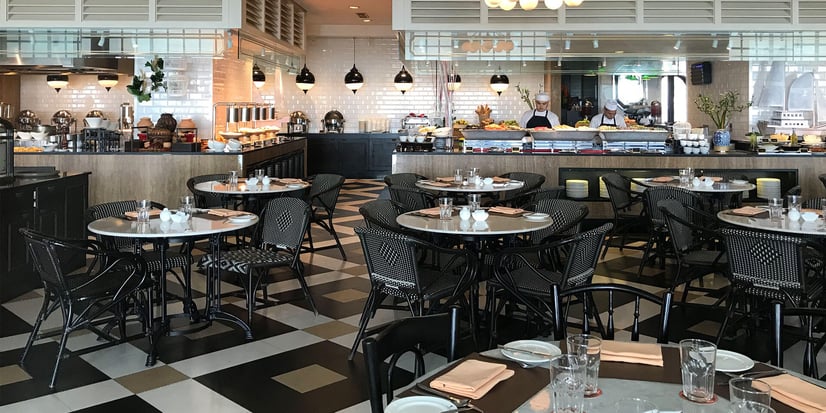LS Retail | 08 March 2022
7 tips to select the right restaurant management software for your QSR chain

As food service customers become more and more accustomed to using technology that speeds up and simplifies the ordering and paying processes, a growing number of quick service (QSR) chains are implementing technologies to grow convenience and better serve customers. As a result, a lot of fast casual and quick service restaurant chains are planning to replace their cumbersome old systems – systems that are often made of different applications bolted together – and implementing instead new technology that can help them boost operational efficiently and satisfy customers’ appetites for a fast, easy and personalized experience. But with so many offerings on the market, how do you choose the one that works best for your business? Here are our tips on how to select the best restaurant management solution for your chain.
1. Look for self-serve options
Modern consumers love taking matters into their hands. Self-service kiosks are the latest thing in self-service ordering, and from their growing popularity, this looks like a trend that is here to stay. Major QSR chains are rolling out self-service kiosk, and some have introduced completely self-service outlets. These in-store self-serve options look set to join online and in-app ordering as must-have capabilities to meet customers’ expectations for fast, convenient ordering. Self-ordering kiosks are also growing fast. The NPD Group reports that the US food service industry saw a 50 percent increase in traffic driven by self-ordering options ordering last year, with QSRs accounting for 98 percent of mobile-pay traffic. Choosing a restaurant management solution that includes online and mobile ordering means you can easily set up integrated self-service solutions. And when it’s all part of the same software system, your customers’ orders are sent automatically to the kitchen for streamlined service, and payments head straight to your back office.2. Enable quick order customization
Menu deals are great for driving business, but today’s consumers love personalization – and they increasingly expect to be able to customize their orders. Enabling them to replace the main, side or drink options you’ve listed with their personal favorite creates big value for your brand. When your restaurant management system has that flexibility built in, it will be easy to change menus and deals on the fly to suit every customer’s taste.3. Connect payments
Your Point of Sale (POS) payment solution is crucial to the smooth operation of your business. But many management systems don’t include an option to integrate this vital piece of kit, leaving you with the burden of having to source it from another provider. This can cause friction between the front and back office, making it difficult to make the changes you need to comply with Payment Card Industry (PCI) requirements, implement EMV (chip and PIN), or to accept gift cards. It also means transactions can get lost in the gaps in the system, so you can’t find the details you need for reports and banking. Choosing a system that offers payment integration is one of the most important decisions you can make for your fast casual or QSR business. When the POS is seamlessly connected, transactions head straight to the back office, exactly where you need them to be.4. Distribute the information
A modern restaurant management solution should make it easy to make changes to menus and prices in the back office and push them out to individual restaurants, groups of stores or the entire chain, no matter whether you use a phased approach or a mass overnight update. This capability is increasingly important, as consumers on the one hand and some industry regulators on the other hand demand that your menus display information about your food, from its caloric and nutritional value, to any allergens it contains, to where the ingredients come from. If you can add that information just once centrally and then roll it out to any stores that need it, you’ll be able to avoid errors and inconsistencies – and, as important, to save yourself hours of repetitive work.5. Make sure it’s intuitive
Efficient operation is the foundation for a great customer experience, so it’s crucial to make sure your restaurant management system is intuitive for management and staff to use. Check out who designed the systems you’re considering – do they have experience in the industry, so they understand what you need and can provide the right tools and workflows? Any operation, from updating the menu across the chain to preparing orders or creating reports, is easier when you only need to log in once and the menus flow in a way that makes sense for the business.6. Keep it all together
By choosing a solution that includes all the functions your business needs, you can eradicate costly and time-consuming system modifications. For example, when a modular kitchen management system is built into the solution, you can easily adapt it to suit different outlets. A large kitchen might have multiple display systems for burgers, fries and drinks stations, while smaller outlets might need only one or two. Your new solution should be flexible enough to deliver exactly what is needed for each restaurant in the chain, without extra cost.7. Look to the future
Cloud computing is a great enabler for flexible business, and restaurants are no exception. Many fast service and QSR businesses are now looking for cloud POS that can run on any device as a way of saving money in specialized hardware. Whether you’re looking for cloud capabilities now or you might consider them in the future, it’s important that your restaurant management system can adapt with your changing needs. Do you still have questions? Do not hesitate to contact us: our hospitality experts are ready to advise you and respond to any doubt you might have.

